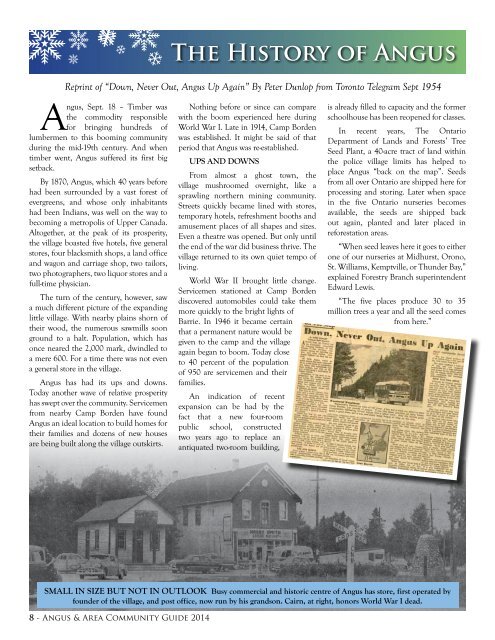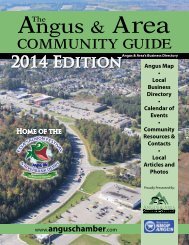2014 AACC Guide
- No tags were found...
Create successful ePaper yourself
Turn your PDF publications into a flip-book with our unique Google optimized e-Paper software.
The History of AngusReprint of “Down, Never Out, Angus Up Again” By Peter Dunlop from Toronto Telegram Sept 1954Angus, Sept. 18 – Timber wasthe commodity responsiblefor bringing hundreds oflumbermen to this booming communityduring the mid-19th century. And whentimber went, Angus suffered its first bigsetback.By 1870, Angus, which 40 years beforehad been surrounded by a vast forest ofevergreens, and whose only inhabitantshad been Indians, was well on the way tobecoming a metropolis of Upper Canada.Altogether, at the peak of its prosperity,the village boasted five hotels, five generalstores, four blacksmith shops, a land officeand wagon and carriage shop, two tailors,two photographers, two liquor stores and afull-time physician.The turn of the century, however, sawa much different picture of the expandinglittle village. With nearby plains shorn oftheir wood, the numerous sawmills soonground to a halt. Population, which hasonce neared the 2,000 mark, dwindled toa mere 600. For a time there was not evena general store in the village.Angus has had its ups and downs.Today another wave of relative prosperityhas swept over the community. Servicemenfrom nearby Camp Borden have foundAngus an ideal location to build homes fortheir families and dozens of new housesare being built along the village outskirts.Nothing before or since can comparewith the boom experienced here duringWorld War I. Late in 1914, Camp Bordenwas established. It might be said of thatperiod that Angus was re-established.UPS AND DOWNSFrom almost a ghost town, thevillage mushroomed overnight, like asprawling northern mining community.Streets quickly became lined with stores,temporary hotels, refreshment booths andamusement places of all shapes and sizes.Even a theatre was opened. But only untilthe end of the war did business thrive. Thevillage returned to its own quiet tempo ofliving.World War II brought little change.Servicemen stationed at Camp Bordendiscovered automobiles could take themmore quickly to the bright lights ofBarrie. In 1946 it became certainthat a permanent nature would begiven to the camp and the villageagain began to boom. Today closeto 40 percent of the populationof 950 are servicemen and theirfamilies.An indication of recentexpansion can be had by thefact that a new four-roompublic school, constructedtwo years ago to replace anantiquated two-room building,is already filled to capacity and the formerschoolhouse has been reopened for classes.In recent years, The OntarioDepartment of Lands and Forests’ TreeSeed Plant, a 40-acre tract of land withinthe police village limits has helped toplace Angus “back on the map”. Seedsfrom all over Ontario are shipped here forprocessing and storing. Later when spacein the five Ontario nurseries becomesavailable, the seeds are shipped backout again, planted and later placed inreforestation areas.“When seed leaves here it goes to eitherone of our nurseries at Midhurst, Orono,St. Williams, Kemptville, or Thunder Bay,”explained Forestry Branch superintendentEdward Lewis.“The five places produce 30 to 35million trees a year and all the seed comesfrom here.”Small In Size But Not In Outlook Busy commercial and historic centre of Angus has store, first operated byfounder of the village, and post office, now run by his grandson. Cairn, at right, honors World War I dead.8 - Angus & Area Community <strong>Guide</strong> <strong>2014</strong>






